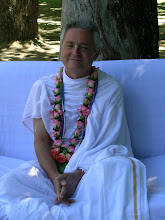
The Vedic civilization describes women of high and noble character and great inner strength, the real examples for humanity (Draupadi, Kunti, Damayanti,etc.).
Even today in India there are women who play the role of spiritual guide and contribute significantly to convey the message of Tradition.
Women in the Vedic tradition play a central part of great dignity, in a sense more valuable than women in the western society, not only socially but above all from anthropological and cosmic viewpoints.
The concept of woman's freedom emerges from the Vedic revelation - mainly from Rig Veda and Atharva Veda – one can not certainly compare it to the model asseverated from the battles of '68: considerable achievements that what's more, have remained on paper.
The artificial acceptance by women of the male social pattern aimed at overcoming the gender discrimination and lack of equal opportunities is certainly not a real solution, nor can it restore to the woman the dignity she deserves.
This dignity can be restored to the extent that women and men learn to value their unique and specific qualities, complementing one another by expressing their nature, talents and potentialities. In solidarity and harmonious cooperation aimed at raising awareness is the key to the completion and realization of both, men and women.
The goal is the rediscovery of one's inner completeness, awakening to one's spiritual origin, God, beyond all duality, beyond the temporary connotations of historical personality, with all its overpowering limitations and conditionings. The Masters of the Vaishnava Bhakti teach us to view ourselves not as men-women, either black or white, but in terms of spiritual entities.
The individuality of the human being is eternal, immutable while the personality is transient and is constituted, as Jung explains, by the sum of the psychic contents with which the individual identifies himself.
Experiences, impressions, facts and external circumstances change the personality, but not individuality.
The historic personality which we can define from autobiographical point of view is often characterized by an imbalance between Logos and Eros. Logos is quest for knowledge, analysis, clarity, rigor, is the law of intellect, the prevailing characteristic of the male character.
Eros represents the principle of hospitality, unity and connection, and is the emotional sphere associated with femininity.
Generally, the person tends to give greater emphasis to one of these aspects (male and female), focusing generally on what is reflected physically.
This polarity between the masculine and feminine sides is the main feature of the human being. The imbalance between these two poles creates a sense of incompleteness and suffering.
Throughout history cultures have mainly favored the masculine aspect compared to that feminine.
Mistaking the physical strength for the moral one, considering the rationality of intellect as superior to intuition, the most important roles in society were granted to men.
Since there is a lack of understanding that the advanced personality of every man and every woman is the result of a synergy and integration between male and female aspects, a static order has been created, producing dichotomies, involution and disharmony.
In reality nobody is exclusively male or female, as in the personality of each are included male and female characteristics, in greater or lesser extent depending on the karmic residue of experiences in this life and in previous ones. The mindset of our past lives remain in our current tendencies, talents, inclinations and innate defects.
Working at the integration of personality is essential to capture the best qualities of male and female characteristics, in order to develop them irrespective of the gender to which one belongs. The goal is recover one's original completeness.
Actually each of us is unique and eternal essence (atman), characterized by a purely spiritual individuality complete in itself.
The embodied being, although the bearer of a body of male or female, should not identify itself neither with gender nor with other psycho-physical characteristics, being aware that they are temporary and external to its inner original nature. All these characteristics represent a mask formed as a result of experiences done and tendencies gained in the course of numerous lives.
When the individual is centered in his self, the two cerebral hemispheres - the right deputed to the imaginative activity and the left to logical and rational one – work in perfect harmony and in accordance with beneficial and powerful dynamics that are activated by compensating any deficiency and karmic imbalances. In that way all the forces that the body uses become forces of development towards holistic wellbeing, and the person becomes the best expression of health and self-realization.
In the sacred Indovedic iconography the figure of God is represented as the ultimate expression of inconceivable unity and perfect combination of masculine and feminine elements.
Similarly, a fully realized human being is the one who rediscovers this divine inner unity, according to Lao-tse, the one who “knows to be male and keeps to be female”.





No comments:
Post a Comment